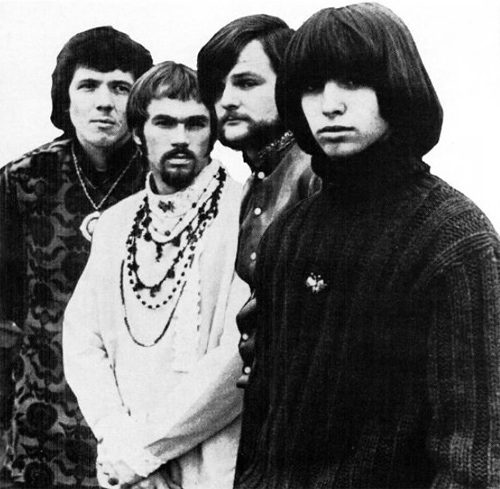Iron Butterfly Brings Metal to the Charts
The origins of heavy metal music remain shrouded in mystery, like the fog-wrapped hills of Middle-earth. Okay, maybe not that mysterious, but it sounds more metal that way, doesn’t it? No matter when you place the beginnings of that loudest of rock subgenres, there’s no argument that 1968 was a monumental year for the artform. Steppenwolf invoked the phrase “heavy metal” in “Born to Be Wild.” Black Sabbath, Led Zeppelin, and Deep Purple each came together. And in the United States, the first so-called metal song entered the charts on July 20 at the hands of San Diego band Iron Butterfly.
Filmmaker Sam Dunn, a Canadian documentarian and metalhead, broke metal down into 26 subgenres for his 2005 feature Metal: A Headbanger’s Journey and subsequent 12-part series Metal Evolution. On his so-called “Family Tree,” he places Iron Butterfly in the Early Metal U.S. division alongside contemporaries like Steppenwolf and Vanilla Fudge. This is important to note as many of the early metal bands simply considered themselves rock bands or “blues-inspired” without consideration to a new label.
As for what makes metal METAL, it seems like every musician, critic, and fan has their own theory. Many scholars point to the down-tuning (a technique which can produce a deeper or heavier sound) used by the likes of Tony Iommi of Black Sabbath, or the prevalent overdrive guitar sound, or the “big bottom” of a pounding rhythm section as typified by Led Zeppelin. Others discuss lyrical content, which runs the gamut from women and parties to occult mysticism to deep dives into fantasy and fringe literature.
Steve Janiak, vocalist and guitarist of Indianapolis-based heavy metal band Devil to Pay, admits that it can be hard for him to define even after having recorded five albums in the genre. “Man, I don’t even know,” he says with a laugh, before noting “volume” and “general overall heaviness” as defining attributes. He also acknowledges the attractive power of that dark side, indicating that he was first drawn to metal because “it was vaguely dangerous or menacing. Something that Mom wouldn’t like.”

Iron Butterfly began their metal journey in San Diego in 1966. The original line-up consisted of Doug Ingle (vocals and organ), drummer Jack Pinney, guitarist Danny Weis, and bassist Greg Willis, though the band would be marked through its tenure by near-constant personnel changes. The band’s first album, Heavy, dropped in early ’68. By the time they recorded their second album that year, the band had become Ingle, Lee Dorman (bass guitar), Ron Bushy (drums), and Erik Brann (guitar and vocals). That second album would be named after a lengthy track called “In-A-Gadda-Da-Vida.”
The unique title comes from, well, drunkenness. As described in the liner notes for Iron Butterfly: Live at the Galaxy 1967, after having a bit too much, Ingle tried to play a song he was writing called “In the Garden of Eden.” Ingle played the organ and sang as drummer Ron Bushy wrote down the lyrics. In his inebriation, Ingle’s slurred pronunciation prompted Bushy to attempt a phonetic spelling, and it stuck. As originally recorded, “In-A-Gadda-Da-Vida” ran 17 minutes; it was edited down to just under 3 minutes and released as a single on June 14, 1968. By July 20, it cracked the U.S. singles charts at No. 117; the tune would reach as high as No. 30, fall off the charts, and then re-enter the Top 100 again in 1969. The strength of the song powered the sales of the album to over 500,000 copies by the end of 1968.
Iron Butterfly performing the tune in 1968.
Listening to the song today, you can easily identify the elements that Janiak and others discuss. There’s that vague mysticism. There are lower tunings and heavy drums (the unedited version features a lengthy drum solo). Ingle’s Hammond organ, a common sound of the era, adds atmosphere, and the guitars convey blues inflections underneath the distortion. It is, simply, metal.

While a version of Iron Butterfly still tours today with drummer Ron Bushy, the band never again matched the success of “In-A-Gadda-Da-Vida.” The album, however, still ranks as one of the best-selling albums in the world, with more than 30 million copies sold. The band helped usher in an acceptance of the sound that paved the way for other acts, like their one-time opener Led Zeppelin.
Metal had a major ascendance and chart dominance in the U.S. during the 1980s. Though it began fading at the hands of the alternative explosion and the proliferation of hip-hop in the early ’90s, metal continues to thrive. Metal bands still tour constantly and sell well. “Family Tree” members Black Sabbath, Led Zeppelin, Deep Purple, Metallica, Kiss, Guns ’N’ Roses, Bon Jovi, Alice Cooper, The Stooges, Van Halen, AC/DC, and Aerosmith have been inducted into the Rock and Roll Hall of Fame, while Steppenwolf’s “Born to Be Wild” was enshrined in the Hall of Fame Singles category in 2018. Metal royalty Slayer embarked on a sold-out retirement tour this year after 37 years of performing. And in June, the theatrical Swedish metal band Ghost saw their fourth album, Prequelle, debut on the U.S. album charts at No. 3.
Fifty years in, metal remains too heavy to push aside.